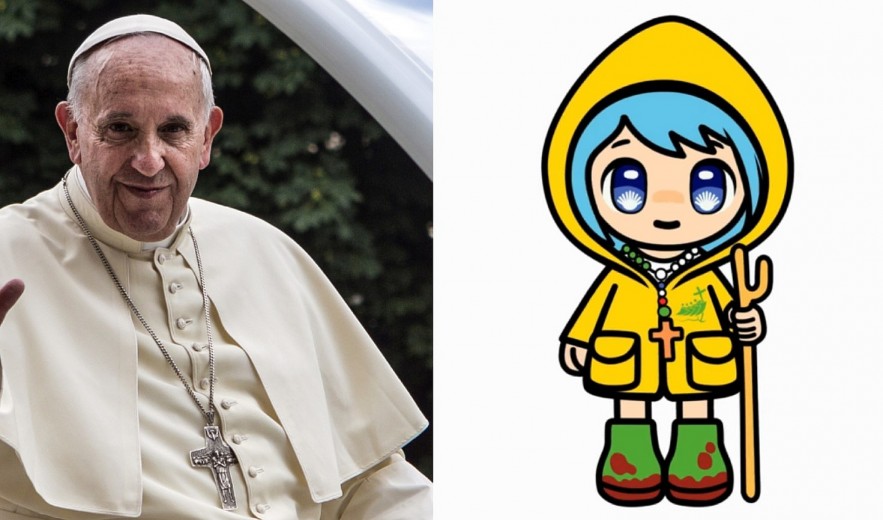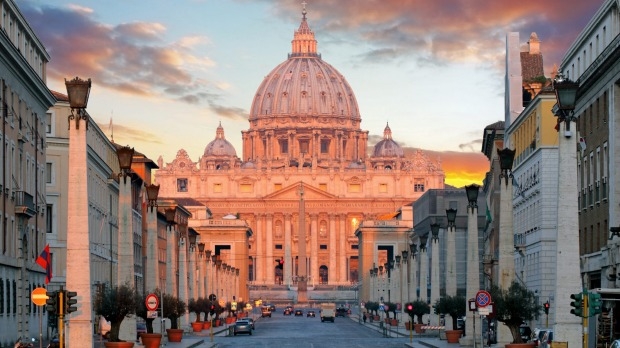Who Is Luce, The Vatican’s New Mascot: Origin, Meaning, Symbolism
The Vatican’s recent introduction of “Luce,” a symbolic mascot, has caught the world’s attention. Embracing this unique addition, the Vatican seeks to connect with global audiences, particularly the youth, through an accessible, unifying, and modern figure. As a mascot, Luce embodies the Vatican's mission to reach out beyond traditional churchgoers, delivering messages of hope, faith, and inclusivity in a contemporary manner.
 |
| The Vatican's new face, an anime mascot named Luce, is dazzling the pop culture world. Luce embodies the Jubilee's theme of Pilgrims of Hope and was created to appeal to younger audiences while promoting the Holy Year 2025. |
The Origins of Luce: Why a Mascot?
A New Way to Communicate
Mascots are traditionally used by organizations, companies, and sports teams to create a friendly, approachable image that resonates with a broad audience. While the Vatican is no stranger to innovation, the adoption of a mascot is an especially novel move for an institution rooted in centuries-old traditions. The Vatican introduced Luce with the goal of fostering a sense of connection with people of all ages, particularly younger audiences who may not traditionally engage with Vatican activities.
The name "Luce," meaning "light" in Italian, captures the essence of the mascot’s role—serving as a beacon that conveys the Vatican’s core messages of love, hope, and understanding in a world that is often polarized. The concept of "light" holds deep spiritual and theological significance within Catholicism, symbolizing divine presence, guidance, and the dispelling of darkness.
Why Now?
The decision to introduce Luce is part of the Vatican's broader strategy to reach out to younger generations and adapt to a rapidly changing world. With digital media transforming the way people engage with religious content, the Vatican sees the mascot as an innovative means of communication that goes beyond traditional methods like sermons and encyclicals. Luce is designed to exist within the digital realm—on social media platforms, websites, and other virtual spaces where younger audiences are more likely to encounter religious messaging.
The timing aligns with Pope Francis’s progressive papacy, which has emphasized inclusion, compassion, and dialogue across religious and secular communities. Luce is meant to bridge gaps, encourage unity, and represent the Church’s commitment to addressing contemporary issues with openness and adaptability.
The Meaning Behind Luce’s Design
Luce is more than a simple character; the mascot is imbued with symbolism that reflects the values and beliefs of the Catholic Church. Designed with careful attention to detail, Luce encapsulates the themes of spirituality, humility, and compassion.
Visual Elements of Luce
Luce’s design is characterized by features that highlight simplicity and warmth. The character often wears a bright, welcoming expression that symbolizes optimism and kindness. Subtle elements such as a halo or a light aura around Luce signify holiness and a connection to the divine, aligning with the Catholic belief that light represents purity and truth.
The colors used in Luce’s design are significant as well. Traditional gold and white tones evoke the Vatican’s official colors, while the addition of blues and greens provides a nod to Earth, peace, and the natural world. This color palette allows Luce to be both visually distinctive and easily associated with the Vatican.
The Symbolism of "Light"
Luce embodies light in a world that often feels shrouded in uncertainty and division. In Christian tradition, light is a powerful symbol of Jesus Christ, who is referred to as the "light of the world." This theological symbolism is essential to Luce’s character, as the mascot serves as a reminder of faith’s power to bring clarity, peace, and joy to followers.
As a universal symbol, light transcends religious boundaries, resonating with people from different backgrounds. In this way, Luce serves as a unifying force, reminding individuals of shared human values like compassion and empathy. The Vatican hopes that Luce’s inclusive message will encourage people of all faiths to consider the values the mascot represents.
The Purpose of Luce: Connecting with the Youth
Addressing the Decline in Youth Engagement
In recent years, the Catholic Church has observed a decline in religious engagement among young people globally. Factors such as secularization, societal shifts, and differing cultural values have contributed to this trend, particularly in Western countries. Many young people today seek spiritual fulfillment outside of traditional religious institutions, and the Church recognizes the need to evolve in order to remain relevant.
Luce’s primary mission is to serve as a bridge between the Church and the younger generation. By presenting religious teachings and values through an approachable mascot, the Vatican aims to spark curiosity and encourage positive associations with the Church. Luce provides a way to convey messages that align with Catholic values but in a way that resonates with the interests and concerns of modern youth.
Digital Outreach: Where Luce Comes Alive
In a digital age where attention spans are short and competition for engagement is fierce, the Vatican has adapted by increasing its presence on social media platforms and using technology to share its message. Luce plays a central role in this digital outreach, appearing in social media posts, animated videos, and interactive content.
Luce’s digital presence is designed to be easily shareable, allowing the Vatican’s messages to reach a global audience quickly. The mascot’s playful and heartwarming content helps break down barriers, making the Vatican’s messages accessible to those who may not otherwise engage with religious teachings. Through Luce, the Vatican is able to reach young people in their own online spaces, providing gentle reminders of faith and morality amid the digital clutter.
The Vatican’s Broader Strategy: Luce’s Role
Building Bridges Beyond the Catholic Community
While Luce was created by the Vatican, the mascot’s message is intended to appeal to a universal audience, not just practicing Catholics. Luce’s themes of love, kindness, and unity are applicable across cultures and religions, and the mascot’s non-denominational approach allows it to transcend religious labels. This inclusivity aligns with Pope Francis’s focus on dialogue, unity, and mutual respect among different faiths.
Luce serves as a soft diplomacy tool for the Vatican, promoting interfaith understanding and encouraging people from all backgrounds to reflect on shared values. The Vatican hopes that Luce’s message will resonate not only with Catholics but with anyone who values compassion and empathy in an increasingly divided world.
A Modern Face for the Vatican’s Timeless Teachings
With Luce, the Vatican has taken a bold step toward blending tradition with modernity. By adopting a mascot, the Church is able to present its teachings in a manner that is both timeless and relevant. Luce brings a friendly, approachable face to concepts that can sometimes feel distant or abstract, making it easier for people to understand and relate to the Church’s teachings.
Luce represents the Vatican’s willingness to evolve and adapt without compromising its core values. By embracing new methods of engagement, the Church aims to show that its teachings are not only applicable to ancient times but continue to hold relevance in today’s complex world.
Reception of Luce Across Cultures
Positive Reception from Youth and Families
Luce has generally been met with enthusiasm, particularly from younger audiences who appreciate the mascot’s accessible, welcoming appearance. Families have responded positively to Luce’s character, as it offers a family-friendly figure that parents can introduce to their children. Luce makes religious teachings more approachable and less formal, helping to foster an early interest in the values promoted by the Church.
Criticism and Skepticism
However, not everyone has welcomed Luce with open arms. Some traditionalists within the Catholic community have expressed skepticism, questioning the need for a mascot within such a historically solemn institution. Critics argue that Luce may oversimplify or dilute the Church’s teachings, reducing complex theological concepts to overly simplistic messages. Despite these criticisms, the Vatican remains committed to Luce’s role in its outreach efforts, viewing the mascot as an important tool for engagement.
Cultural Variations in Interpretation
The reception of Luce has also varied across cultural contexts. In some regions, where mascots are popular symbols of community and identity, Luce has been embraced as a unique addition to the Vatican’s image. In other areas, the concept of a mascot may feel foreign or unusual. Despite these cultural differences, the Vatican believes that Luce’s universal themes of hope and compassion will ultimately resonate across diverse backgrounds.
Conclusion
In creating Luce, the Vatican has introduced a mascot that represents the institution’s aspirations for unity, inclusivity, and dialogue in the modern age. Through Luce, the Vatican seeks to connect with younger audiences, bridge gaps with people of different faiths, and offer a fresh approach to spreading messages of faith and compassion. The Vatican’s embrace of digital innovation through Luce reflects its commitment to evolving while staying rooted in its core beliefs.
Luce is more than just a character; it symbolizes a new era of engagement for the Vatican, demonstrating that tradition and modernity can coexist harmoniously. As Luce continues to engage with people worldwide, it is likely that the mascot will become a familiar figure, bringing light to a world that is often in need of warmth and hope.
Frequently Asked Questions (FAQs)
Q: What does Luce mean?
A: "Luce" means "light" in Italian, symbolizing guidance, hope, and the presence of divine love in Catholic teachings.
Q: Why did the Vatican choose a mascot?
A: The Vatican introduced Luce as a means to engage younger audiences, foster unity, and make religious teachings more approachable in the digital age.
Q: How can I follow Luce’s activities?
A: Luce has a digital presence on social media platforms and the Vatican’s official website, where you can see updates, stories, and interactive content featuring the mascot.
Q: Is Luce aimed only at Catholics?
A: No, Luce’s messages of compassion and kindness are intended to appeal to a broad audience, including people of various faiths and backgrounds.
Q: Will Luce be used in Vatican events?
A: Yes, Luce may appear in certain Vatican events, particularly those involving youth engagement, to create a friendly, accessible presence for the Church’s teachings.
 Which Country is The Smallest in the World? Which Country is The Smallest in the World? The smallest country in the world has the area of only 44 hectares. What country is that: Population, Territory, Interesting Facts and Figures? Find ... |
 What Are The City States: Vatican, Monaco And Singapore What Are The City States: Vatican, Monaco And Singapore What is "City-State"? We will guide you through the definition, characteristics, history, and examples. |
























